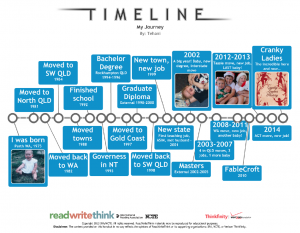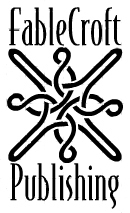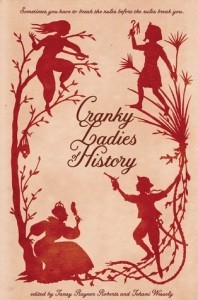Tehani Croft Wessely's Blog, page 10
March 25, 2015
CRANKY LADIES OF HISTORY: The Pirate Queen of the Connacht
 Welcome to Women’s History Month 2015, which has the theme “Weaving the stories of women’s lives”, which fits perfectly with our Cranky Ladies of History anthology project! After 18 months of work, including our successful crowd-funding campaign in March last year, we are proudly releasing the anthology on March 8. To celebrate, our wonderful authors have supplied blog posts related to their Cranky Lady, and we are delighted to share them here during the month of March.
Welcome to Women’s History Month 2015, which has the theme “Weaving the stories of women’s lives”, which fits perfectly with our Cranky Ladies of History anthology project! After 18 months of work, including our successful crowd-funding campaign in March last year, we are proudly releasing the anthology on March 8. To celebrate, our wonderful authors have supplied blog posts related to their Cranky Lady, and we are delighted to share them here during the month of March.
To get your own copy of Cranky Ladies of History, you can buy from our website, order your favourite real world bookshop, or purchase at all the major online booksellers (in print and ebook).
The Pirate Queen of the Connacht by Dirk Flinthart
Grace O’Malley: a woman so swashbuckling and amazing that she really ought to be fictitious, because her actual-factual self makes most of us look like timorous, lazy slugs.
Look – I like pirates, okay? I’ve liked pirates ever since I was old enough to read Treasure Island for myself. (My mum read it to me first, but she was going too slowly for me. I kidnapped the book and read it in a day.) I know that in reality, most pirates were (and are) amoral, bloodthirsty, violent thugs… but every now and again somebody like Grace O’Malley crops up.
POTENTIAL SPOILERS FOR “Granuaile” AFTER THE CUT – check out the story in Cranky Ladies of History before you read!
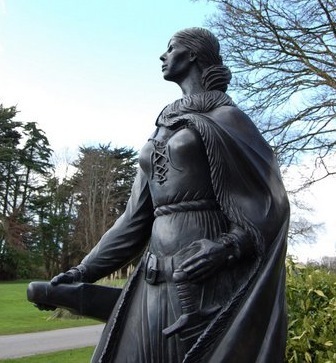 Grace (Gráinne Ní Mháille – ah the lovely Irish spelling!) was born in 1530, likely in the vicinity of Clew Bay over in the west of Ireland in County Mayo. She was the daughter of the chief of the O’Malley clan, a fierce man known as Dubhdara, or “The Black Oak”. The O’Malleys were a sailing clan, and they controlled a significant chunk of the waterway over there in the west. While they styled themselves as traders and carriers, there was always a strong sideline in offering “protection” to people passing through their waters, and more than a little piracy when they thought they could get away with it.
Grace (Gráinne Ní Mháille – ah the lovely Irish spelling!) was born in 1530, likely in the vicinity of Clew Bay over in the west of Ireland in County Mayo. She was the daughter of the chief of the O’Malley clan, a fierce man known as Dubhdara, or “The Black Oak”. The O’Malleys were a sailing clan, and they controlled a significant chunk of the waterway over there in the west. While they styled themselves as traders and carriers, there was always a strong sideline in offering “protection” to people passing through their waters, and more than a little piracy when they thought they could get away with it.
Grace started young. The story goes that as a girl, she wanted to go on an expedition to Spain with dear old dad. Upon being told she couldn’t go ‘cos she was a girl and all that girly long hair would get caught in the ropes, she hacked her hair off short – which led to the nickname ‘Grainne Maol’, or “Bald Grace”. The Anglicised version is Granuaile, and it stayed with her throughout her long and interesting life.
It’s not easy to separate fact from fiction where Grace is concerned. Written records about her come mostly from the correspondence of the English nobles of the time, many of whom were rather unhappy with her. Her longtime arch-enemy Richard Bingham (appointed the boss of Connacht in the name of Her Majesty, Queen Elizabeth I) wrote that she was “nurse to all rebellions in the province for this forty years.”
What we do know is enough. After her father died, Grace became leader of the O’Malley clan business. This was a bit unorthodox, but throughout her life Grace clove to the old Brehon law of Ireland, which treated women with much more equality than did the laws of the Christian churches or the English law. Certainly, nobody appeared to want to disagree with her when she took over.
At sixteen, she married the heir to the O’Flaherty clan, one Dónal “an Chogaidh” Ó Flaithbheartaigh (Donal of the Battle), also known as Donall an Cullagh, “the Cock”. (You know what? I’m not doing this Irish spelling thing any more. I don’t think I have enough consonants to spare…) Donal was a fighter, but not necessarily the smartest guy in the room. Grace had three kids with Donal, but after he died there was some disagreement between her and her two sons over her chunk of the inheritance, so she went back to home territory (taking with her a couple-hundred followers with all their goods and gear) and went into business for herself in a big way.
We know she was a fighter. Husband Donal died in a raid from the Joyce clan as they tried to take back a castle he’d taken from them. Grace’s defense of that same castle was so savage and fierce that the name was changed from “Cock’s Castle” to “Hen’s Castle”. She took a bit of a shine to the place, and at one point the English tried to winkle her out. The battle went on long enough that the defenders ran out of shot. The English thought all their Christmasses had come at once – until Grace had the roof of the castle melted down and replied to their attack with a withering fusillade. Once the English retreated, she sneaked a messenger out by a secret passage. Beacon fires were lit – and her fleet turned up, trouncing the English and ending the siege.
We know she was a lover. She took another husband after Donal, a man named Richard Bourke, also called Richard-An-Iarainn, or “Iron Dick”. She bore him a son, but after a period of time she holed up in her favourite of Richard’s castles and when he turned up she famously said: “Richard, I dismiss you.” This was a divorce under the Brehon law, and Grace kept the castle (which had nice views and a very useful sea-port attached, apparently.) Despite this, she and Richard kept their relationship going, and when he died the English regarded Grace as his widow.
She did like men, and she didn’t care who knew it which made her something of a scandal in those times. In a notorious event, her lover Hugh de Lacey (a lad fifteen years her junior whom she’d rescued from a shipwreck) was killed by members of the MacMahon clan. The story goes that Grace tracked the killers to an island and killed them by her own hand. Whether or not that’s true, she certainly burned the MacMahon boats and seized their castle at Doona with considerable bloodshed.
The stories about her are fabulous. She’s supposed to have given birth to her son (by Richard) aboard one of her boats, which was then attacked by slave-takers. The fight wasn’t going so well until Grace came up from below with a blunderbuss which she unloaded into the slavers, spearheading a counter-attack which drove them into the sea. Another story: refused traditional hospitality at Howth castle, she kidnapped the Lord of Howth’s son. The ransom? The Lord of the Castle was never to close his gates to anyone asking for hospitality, and an extra place was to be set at the table each evening. To this day, they set an extra place at the table in Howth Castle – although I suspect that if you turned up demanding hospitality they’d probably point you to the nearest B’n’B.
Her struggles against Richard Bingham went on for decades. At one point, her son (by Donal) Murrough took Bingham’s side against her. Her response? Grace burned his ships, stole his cattle and sacked his town. Tough love, yeah?
Times were changing, though. The English were forcing the clan leaders to submit, taking their lands from them and then regranting them, forcing them to accept English law. By 1593, Grace was in a bad position with her lover and at least one of her children imprisoned. She’d been writing to Queen Elizabeth for some time, apparently – but at this point I guess she figured enough was enough. In a move that took truly breathtaking self-confidence, Grace went to England seeking private, personal audience with the English queen.
She got it.
That boggles my mind. Pirate, “traitor”, “rebel”, and adherent to the vanishing laws and customs of a country that England viewed as a barbarous vassal territory, somehow Grace O’Malley got permission for a face-to-face chat with the Queen herself. It is recorded that she would not bow to Elizabeth, as she did not recognise her as Queen of Ireland. Unfortunately, there are no records of their discussion, as it was carried out more or less privately. (There were guards, yes. But Grace and Elizabeth conversed in Latin, the only language they shared with fluency.) And we know that after the meeting, Grace was permitted to return to Ireland and take up her “trade” once again, on the promise of “good behaviour.” Oh, and Richard Bingham was removed from office – for a time, at least.
In 1603, Grace O’Malley died. Exactly where and when isn’t certain. What is known is that even into her early seventies, she was still leading her ships, still taking part in raids and “protection”. (And what must her victims have thought, seeing a grey-haired woman commanding the attackers?)
And as for the story in “Cranky Ladies?” Well, apparently Grace was well known to young Philip Sidney. They spent much time in conversation, and he seemed to find her fascinating. Indeed, his letters home provide a significant part of the scant historical record on this remarkable woman. There must have been a first meeting between the two at some point. I like to think that the events of the story “Granuaile” would have suitably impressed the young poet and courtier with regard to the wonderfully fierce, courageous, cunning – and undoubtedly cranky – Grace O’Malley, Pirate Queen of the Connacht.
Want to know more? You could try these resources:
Chambers, Anne. Granuaile: Ireland’s pirate queen Grace O’Malley c. 1530–1603. Dublin: Wolfhound Press. ISBN 0-86327-913-9.
Cook, Judith (2004). Pirate Queen, the life of Grace O’Malley 1530–1603. Cork: Mercier Press. ISBN 1-85635-443-1.
Badass of the Week website.
March 23, 2015
CRANKY LADIES OF HISTORY: Countess Bathory
 Welcome to Women’s History Month 2015, which has the theme “Weaving the stories of women’s lives”, which fits perfectly with our Cranky Ladies of History anthology project! After 18 months of work, including our successful crowd-funding campaign in March last year, we are proudly releasing the anthology on March 8. To celebrate, our wonderful authors have supplied blog posts related to their Cranky Lady, and we are delighted to share them here during the month of March.
Welcome to Women’s History Month 2015, which has the theme “Weaving the stories of women’s lives”, which fits perfectly with our Cranky Ladies of History anthology project! After 18 months of work, including our successful crowd-funding campaign in March last year, we are proudly releasing the anthology on March 8. To celebrate, our wonderful authors have supplied blog posts related to their Cranky Lady, and we are delighted to share them here during the month of March.
To get your own copy of Cranky Ladies of History, you can buy from our website, order your favourite real world bookshop, or purchase at all the major online booksellers (in print and ebook).
Countess Bathory by Deborah Biancotti (“Look How Cold My Hands Are”)
She was called witch, Vampire, the Blood Countess and the Beast of Cjeste. She was accused of bathing in the blood of virgin girls. She’s been described as the worst female serial killer of all time, with her victims numbering anywhere from fifteen to three hundred to six hundred girls and women.
Since the eighteenth century she’s been held up as an example of the evils of feminine vanity, a woman who painted her face with blood in order to preserve her youth.
And yet, she died nearly two hundred years before the worst of these claims were ever made.
POTENTIAL SPOILERS FOR “LOOK HOW COLD MY HANDS ARE” AFTER THE CUT – check out the story in Cranky Ladies of History before you read!
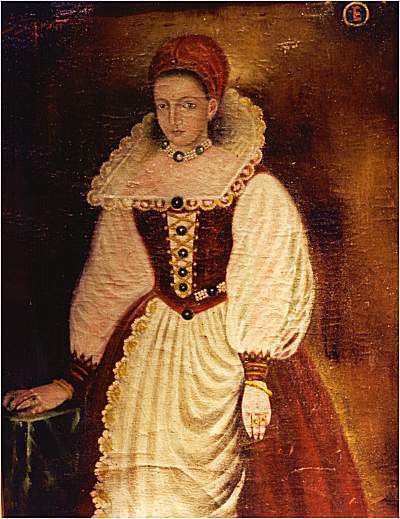
Erzsébet Nádasdy (1560-1614), the last Countess of Báthory, was once one of the wealthiest and best educated women in Europe. She was related to Transylvanian royalty. The Palatine (i.e. Prime Minister) of Hungary was her cousin, as were many of the Protestant nobles of Hungary.
In public, she was a pious, reserved woman, who dutifully followed the Catholic king, Matthias II, and took pains to look after the people of her estates. She’d been raised Calvinist and frequently attended religious service. She’d suffered fits since she was a child, and her first daughter (born out of wedlock) was spirited away before her marriage to a Hungarian war hero. Count Ferenc Nádasdy, known as the Black Knight of Hungary, was famous for his brutal treatment of the invading Islamic Ottoman Empire.
But Hungary was poor. Two hundred years of fighting the Ottomans had left the people starving and the nobles suffering. The seat of Nádasdy was owed a substantial debt by the Hapsburg king, who left it to landholders to fund their own armies, hospitals, schools and roads. Erzsébet’s financial management was further hampered by her husband’s generous donations to the church to keep them from speaking out about Erzsébet’s crimes and the unusual number of deaths on her lands.
Because Erzsébet was a murderer.
But she rarely murdered alone.
Hungarian nobles of the time thought of the people who lived on their lands as their wards, servants and—in some sad situations—their property. Nobles like Erzsébet believed themselves to be above the law.
The dead girls that were buried or dumped on Báthory-Nádasdy lands were usually in Erzsébet’s employ when they died. They were starved and tortured to death by the Countess—and others. Her husband, her daughters, her fellow noble women and even her most loyal servants.
But it wasn’t until Erzsébet established a ‘gynaecium’ (a school for the education of lesser noble girls) that she set herself against the rest of noble Hungary and drew the attention of a king keen to dissolve his debt to her family.
Within weeks of the school’s opening, all the students were dead.
Their families petitioned the king for justice, and the king was keen to oblige. At least, he was keen to see an end to Erzsébet’s embarrassing habit of turning up at court to demand repayment of the royal debt.
But Erzsébet’s cousin, Palatine György Thurzó, had promised Ferenc Nádasdy on his deathbed that he would protect Erzsébet and the family. Like Erzsébet, György was more Protestant than Catholic, and like Erzsébet, he was of noble blood and possibly suspicious of the king’s motivations. He personally visited Erzsébet at her manor in mid-1610.
After eating cake offered by the Countess, the Palatine and all his men were struck by a mysterious illness. They fled her manor immediately.
If Erzsébet thought that was an end to the matter, she was wrong. Instead, the Palatine waited for Parliament to retire for the year. Then he made a mad dash to the Cjeste manor one snowy Christmas evening. Refusing any sustenance, he and his men searched the manor and nearby castle. They found dead and dying girls and woman, many with the marks of torture still on bodies that had been left to pile up in the castle keep.
This time, the Palatine executed the rights of his office to declare sentence without trial. Ignoring Erzsébet’s insistence that she be given a right to defend her name, the Palatine banished her to life under house arrest. She was to be walled up in Cjeste Castle for the rest of her life—the very castle that had been a wedding gift from her new in-laws in 1575. He further decreed that all her personal papers be destroyed. She would not be allowed to write to any of her noble family or friends.
Finally, he decreed that her name would never again be uttered in public.
True to form, most documents not owned by Erzsébet’s direct descendants were destroyed. She lived for four years inside Cjeste, under guard and behind a brick wall that allowed only plates and pots to be passed.
She died after complaining about the coldness in her hands, but it was several days before they knocked down the walls to find her dead, her food trays lined up untouched, and writing all over the walls. It was 1614.
By then anything Erzsébet had not already willed to her two remaining daughters and son were seized by the crown. Her impressive collection of jewels, mostly plundered from the Ottomans, were stolen by the Palatine’s wife (so brazenly that nobles petitioned Parliament to stop her).
There was a full investigation during Erzsébet’s internment and the report was discovered to be so damning—not just of Erzsébet but of a great many nobles—that even the king was forced to bury the Báthory issue. Matthias II went on to impress the Catholic church so much with his wealth and standing that he was made Emperor of Rome.
Two hundred years later, when the first vampire craze swept Europe, Erzsébet was retrospectively labelled vampire and the stories of her bloody baths were first recorded.
And the number of girls she killed? Likely reports put it at around thirty. Which is bad enough, of course. The one claim of six hundred dead came from a nine-year-old serving girl and was faithfully recorded in the report because Hungary, at the time, believed a child was incapable of lying.
Erzsébet’s body was first laid to rest in the town of Cjeste. But locals objected so vociferously that the family had her moved to a secret location. Many of Erzsébet’s documents are potentially still concealed by the family, and several related documents have never been translated out of the original Hungarian.
The only known portrait of Erzsébet, Countess of Báthory, was stolen from Cjeste Museum in the 1990s and has never been located.
It seems history is intent on burying the real Erzsébet Nádasdy.
March 19, 2015
CRANKY LADIES OF HISTORY: Hatshepsut’s rise to power
 Welcome to Women’s History Month 2015, which has the theme “Weaving the stories of women’s lives”, which fits perfectly with our Cranky Ladies of History anthology project! After 18 months of work, including our successful crowd-funding campaign in March last year, we are proudly releasing the anthology on March 8. To celebrate, our wonderful authors have supplied blog posts related to their Cranky Lady, and we are delighted to share them here during the month of March.
Welcome to Women’s History Month 2015, which has the theme “Weaving the stories of women’s lives”, which fits perfectly with our Cranky Ladies of History anthology project! After 18 months of work, including our successful crowd-funding campaign in March last year, we are proudly releasing the anthology on March 8. To celebrate, our wonderful authors have supplied blog posts related to their Cranky Lady, and we are delighted to share them here during the month of March.
To get your own copy of Cranky Ladies of History, you can buy from our website, order your favourite real world bookshop, or purchase at all the major online booksellers (in print and ebook).
Hatshepsut by Amanda Pillar (“Neter Nefer”)
There is surprisingly little data on the early days of Hatshepsut’s rise to power (at least, in the records I trawled through). She is regarded as one of the most successful pharaohs of Egypt and is from the same dynasty as the famous Tutankhamun and the rule-breaking Akhenaten.
But what inspired Hatshepsut to claim the double crown?
POTENTIAL SPOILERS FOR “NETER NEFER” AFTER THE CUT – check out the story in Cranky Ladies of History before you read!

Well, we don’t really know. I wish I could say that my story was based on solid fact, being an archaeologist, but record-keeping about kings seems to kick off once they are actually, well, kings. We do know that Hatshepsut technically ruled jointly with Thutmose III, her stepson. There has been much debate as to Thutmose III’s feelings regarding Hatshepsut’s usurping of his throne, but he later became known as the Napoleon of Egypt. With a reputation like that, it seems unlikely that he was angry about his delay in governing the two kingdoms, but that is just idle speculation – especially as there is the small fact that during Thutmose III’s reign, he began obliterating Hatshepsut’s name from the record. There are, again, many theories as to why he went to such an extreme act, or why he may have delayed doing so in the first place.
But just for fun, here are a few facts about Hatshepsut and the story:
Hatshepsut had the beautiful Djeser-Djeseru mortuary temple built, although she was not buried there. It is thought to have inspired the creation of the well-known Valley of the Kings.
Thutmose II– Hatshepsut’s husband and half-brother – was not murdered, like in the story. According to an old reference, his mummy was badly treated, and had sustained great damage. However, even the destruction couldn’t hide traces of an illness that resulted in scars.
There is debate as to whether Hatshepsut’s daughter, Neferure, married Thutmose III. She may have.
Thutmose III was actually almost a decade older than Neferure, rather than younger, as in the story. Neferure appears to have died at the age of 16. She was, however, a prominent member of her mother’s court.
Hatshepsut’s mummy was thought to have been found on the floor of a tomb (KV60) belonging to her wetnurse. Her wiki page says she possibly died from a carcinogenic skin lotion, which may have caused bone cancer. CT scans have shown she did have cancer, and was also apparently obese.

So while we will never really know the hows and whys of Hatshepsut’s rise to power, we can rest assured that she was an important figure of ancient history; and not the only female king Egypt saw…
March 15, 2015
CRANKY LADIES OF HISTORY: Due Care with the Truth (Dr Lilian Cooper)
 Welcome to Women’s History Month 2015, which has the theme “Weaving the stories of women’s lives”, which fits perfectly with our Cranky Ladies of History anthology project! After 18 months of work, including our successful crowd-funding campaign in March last year, we are proudly releasing the anthology on March 8. To celebrate, our wonderful authors have supplied blog posts related to their Cranky Lady, and we are delighted to share them here during the month of March.
Welcome to Women’s History Month 2015, which has the theme “Weaving the stories of women’s lives”, which fits perfectly with our Cranky Ladies of History anthology project! After 18 months of work, including our successful crowd-funding campaign in March last year, we are proudly releasing the anthology on March 8. To celebrate, our wonderful authors have supplied blog posts related to their Cranky Lady, and we are delighted to share them here during the month of March.
To get your own copy of Cranky Ladies of History, you can buy from our website, order your favourite real world bookshop, or purchase at all the major online booksellers (in print and ebook).
Due Care with the Truth by Sylvia Kelso (“Due Care and Attention”)
POTENTIAL SPOILERS FOR “DUE CARE AND ATTENTION” – check out the story in Cranky Ladies of History before you read!
When you read fiction about a person from actual history, it’s a very natural reaction to ask, How much of this was true?
In my case, quite a lot of the story about Dr Lilian Cooper and her best mate Josephine Bedford is based on fact. Quite a few of Lilian’s remarks were recorded, and a few are used here verbatim, though the curses are manufactured. However, the details of the night trip to Mount Mee are accurate, as is the fractured skull – in 1893 the horse in her dog-cart bolted and threw her into a lamp-post; Lilian was picked up vowing that nothing was wrong, but she was confined to bed for some time, even having the street outside covered with straw, a sign, then, of a dangerously ill patient. When she recovered, Josephine quietly replaced the groom, and drove Lilian on her medical rounds. All to be found in Lilian’s biography, No Easy Path, by Lesley M. Williams.

Image courtesy of the State Library of Queensland
Also true is the furore over (relative) speeding on which the story is based. There was a Brisbane cop who excelled in fining speedsters, among whom doctors were notable, both Lilian and Dr Hardie copping the fines cited here. There was also a bill mooted to give police the powers listed. The then stagnant RACQ did resurrect itself to fight the bill, and said bill was dropped: all related in Robert Longhurst’s A Road Well Travelled: RACQ’s first 100 years. The Lennons payroll robbery and the car-chase, however, are definitely fiction. And it’s also fiction that the cop who issued speeding fines was called Higgins.
March 13, 2015
CRANKY LADIES OF HISTORY: Elizabeth Tudor, last Queen standing
 Welcome to Women’s History Month 2015, which has the theme “Weaving the stories of women’s lives”, which fits perfectly with our Cranky Ladies of History anthology project! After 18 months of work, including our successful crowd-funding campaign in March last year, we are proudly releasing the anthology on March 8. To celebrate, our wonderful authors have supplied blog posts related to their Cranky Lady, and we are delighted to share them here during the month of March.
Welcome to Women’s History Month 2015, which has the theme “Weaving the stories of women’s lives”, which fits perfectly with our Cranky Ladies of History anthology project! After 18 months of work, including our successful crowd-funding campaign in March last year, we are proudly releasing the anthology on March 8. To celebrate, our wonderful authors have supplied blog posts related to their Cranky Lady, and we are delighted to share them here during the month of March.
To get your own copy of Cranky Ladies of History, you can buy from our website, order your favourite real world bookshop, or purchase at all the major online booksellers (in print and ebook).
Elizabeth Tudor: Last Queen Standing by Faith Mudge (“Glorious”)
To understand how Elizabeth Tudor became the woman she was, you need to know a few things about her father.
At a huge diplomatic event known as the Field of the Cloth of Gold, King Henry VIII of England challenged the French king to a public wrestling match. (He lost.) When the Pope refused permission for him to divorce his first wife, he changed the whole religious structure of his country so that he could do what he wanted. When his second wife, Anne Boleyn, bore a girl instead of the son he expected, he refused to attend the christening. He divorced Anne of Cleves after six months because he decided she wasn’t pretty enough, ordered for Catherine Parr to be arrested when she argued with him and is reputed to have been playing tennis while Anne Boleyn was executed.
In short, he was a violent egomaniac whose word was law, and who placed little worth on the lives of women. Not an ideal father for two daughters.

Elizabeth was born on the seventh of September in 1533, during the volatile years of the Reformation, when the only safe belief you could have about anything was ‘whatever the king says’. She was not quite three years old when her mother was beheaded, and her father remarried in the same month. This marriage, to Jane Seymour, soon produced the son he craved so much. That left Elizabeth, his middle child, in an immensely precarious position – disinherited, declared illegitimate, essentially superfluous and a living reminder of the woman Henry had loved then hated.
You could say that’s when I met her. The first incarnation of Elizabeth I remember encountering was an article in an old magazine, and the sense of isolation it conjured has stuck with me: an image of a little girl surrounded by whispers and watchful eyes. The only person Elizabeth could count on to protect her was herself.
POTENTIAL SPOILERS FOR “GLORIOUS” AFTER THE CUT – check out the story in Cranky Ladies of History before you read!
I get my love of history from my mother; she celebrated our family’s English heritage with BBC history documentaries and let me watch them all with her from a very young age. She also encouraged me to devour my own body weight in fictional biographies about girl monarchs and bought me enough historical novels last Christmas to build a small fort. My sister has also been a strong influence – we celebrated my twenty first birthday by watching a joust and sighing over medieval weaponry.
All that immersion in history has had two lifelong effects: I am permanently cured of any desire to time travel (they didn’t have toothpaste) and the inside of my head resembles a disorganised museum, with half-forgotten facts scattered in odd corners. My favourite eras get labels. The Tudors, to carry this metaphor too far, get a display case.
As monarchs, they were a special brand of disastrous. Henry inflicted his personal religious crisis on the whole kingdom. His beloved son Edward was a passionate Protestant; Edward’s older sister Mary was a fervent Catholic. Both expressed their beliefs by persecuting the other side and where possible, setting them on fire.
Then along came Elizabeth. That she survived the political whiplash is extraordinary enough, and testament to her innate political instinct. Tudor monarchs would not tolerate anyone who stood in their way. Yet Elizabeth, repeatedly disinherited, dismissed by her father and brother because of her gender, ended up as the last one standing. History doesn’t footnote her as Henry’s daughter; she lives on as Gloriana, the Virgin Queen, a woman ‘with the heart and stomach of a king, and a King of England too!’
I found out when I started researching her life in depth that a lot of historians don’t like her as much as me.
A History of Great Britain, published by Longmans, Green and Co. in 1910, says she was “coarse and unscrupulous, and she never hesitated to tell lies… She was vain and selfish, and found it hard to make up her mind in little things” before reluctantly conceding that “in great matters she showed rare strength and firmness of purpose”. Considerably more recent biographies portray her as a careless flirt dallying with her stepmother Catherine Parr’s handsome husband Thomas Seymour–conveniently glossing over the fact Elizabeth was fourteen and Seymour was almost forty–also, that Catherine knew about the ‘horseplay’ and actively participated in it. In the 16th century, people might have blamed a teenage girl for attracting the attentions of a much older man, but we should be better than that by now. We need to be better than that.
And yes, Elizabeth was vain. She was touchy about her height and was known to threaten people who upset her that she would make them ‘shorter by a head’. She didn’t keep her looks, thanks to a sugar addiction and toxic Tudor make-up (her teeth went black and she ended up wearing a wig) but she would not allow unflattering portraits. Painters had to copy the one she liked instead.
Elizabeth was a brilliant scholar, fluent in a plethora of languages. She also liked blood sports, fabulous clothes and half-dressed men playing tennis. She demanded devotion from those who served her–she once smacked one of her courtiers on the back the head for turning his back on her during an argument–but rewarded those who stayed loyal. Though she inherited her father’s hot, resentful temper, she had her mother’s caution too. Exceptionally skilled at not agreeing to things, she was very hard to back into a corner. Men of the court who tried to coerce or bully her soon found out it was useless. In a time when princesses were betrothed in their infancy for maximum political advantage and a woman ruling in her own right was considered an aberration, she never married. The crown was hers alone.
She doesn’t have to be loveable to be remarkable.
Elizabeth died on the 24th of March, 1603, having reigned over England for nearly half a century. She was the fifth and last monarch of the Tudor line. If only Henry could have known that the daughter whose christening he refused to attend would one day eclipse his legacy altogether. Maybe time travel would be fun after all.
Team Gloriana forever.
March 11, 2015
Cranky Ladies bits and bobs
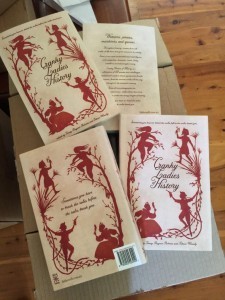 Tansy and I wrote a post for John Scalzi’s Big Idea series over at his blog. If you are interested in knowing more about how Cranky Ladies of History came to be, check it out here!
Tansy and I wrote a post for John Scalzi’s Big Idea series over at his blog. If you are interested in knowing more about how Cranky Ladies of History came to be, check it out here!
Some of our wonderful authors have given us guest blogs about their cranky lady and the writing of their stories. So far we have shared Havva Murat’s journey with Nora of Kelmendi and Juliet Marillier has talked about Hildegard of Bingen.
We’re starting to see some lovely reviews for the book:
Shelleyrae at Book’d Out said: “Cranky Ladies of History is an important collection of fiction that gives voice to an extraordinary selection of women from a broad range of backgrounds, eras and cultures. I wouldn’t hesitate to recommend it.”
At Adventures of a Bookonaut, Sean was very complimentary about Cranky Ladies, saying the book is “a unique project in that it delivers entertainment while spotlighting 22 women of history that we should all know more about, even if it’s for the simple reason that their stories are different to those we are used to hearing.”
Katharine at VentureAdlaxre comprehensively considered the anthology, giving it five stars!
March 9, 2015
CRANKY LADIES OF HISTORY: Juliet Marillier’s author notes for “Hallowed Ground”
 Welcome to Women’s History Month 2015, which has the theme “Weaving the stories of women’s lives”, which fits perfectly with our Cranky Ladies of History anthology project! After 18 months of work, including our successful crowd-funding campaign in March last year, we are proudly releasing the anthology on March 8. To celebrate, our wonderful authors have supplied blog posts related to their Cranky Lady, and we are delighted to share them here during the month of March.
Welcome to Women’s History Month 2015, which has the theme “Weaving the stories of women’s lives”, which fits perfectly with our Cranky Ladies of History anthology project! After 18 months of work, including our successful crowd-funding campaign in March last year, we are proudly releasing the anthology on March 8. To celebrate, our wonderful authors have supplied blog posts related to their Cranky Lady, and we are delighted to share them here during the month of March.
To get your own copy of Cranky Ladies of History, you can buy from our website, order your favourite real world bookshop, or purchase at all the major online booksellers (in print and ebook).
A few notes on Hildegard of Bingen by Juliet Marillier (“Hallowed Ground”)
We couldn’t place author notes within the anthology itself, but wanted to share them with our readers. Juliet had some things she wanted to add about Hildegard of Bingen, the subject of her story “Hallowed Ground”.
POTENTIAL SPOILERS FOR “HALLOWED GROUND” – check out the story in Cranky Ladies of History before you read!
 The most challenging aspect of writing about Hildegard of Bingen, 12th century Benedictine nun, composer, scholar and visionary, was deciding what aspect of her long and extraordinary life I might best fit within the confines of a short story. Hildegard was a woman before her time, intellectually brilliant, creative and original, a natural leader. And yet, from the age of seven, when she was enclosed with Jutta the anchoress at Disibodenberg, to the age of thirty-eight, when she assumed leadership of the nuns on Jutta’s death, very little is recorded of her life save that she was admired for her piety. We know that her mentor and secretary, Volmar, persuaded her to record in writing the powerful visions she had experienced since early childhood. In the second half of her life Hildegard composed remarkable poetry and music that broke the existing boundaries of religious chant; she wrote several scholarly treatises and many letters. She was unafraid to criticise the practices of Church authorities if she believed them unjust. Once Pope Eugenius had sanctioned her visions, her influence was greatly strengthened.
The most challenging aspect of writing about Hildegard of Bingen, 12th century Benedictine nun, composer, scholar and visionary, was deciding what aspect of her long and extraordinary life I might best fit within the confines of a short story. Hildegard was a woman before her time, intellectually brilliant, creative and original, a natural leader. And yet, from the age of seven, when she was enclosed with Jutta the anchoress at Disibodenberg, to the age of thirty-eight, when she assumed leadership of the nuns on Jutta’s death, very little is recorded of her life save that she was admired for her piety. We know that her mentor and secretary, Volmar, persuaded her to record in writing the powerful visions she had experienced since early childhood. In the second half of her life Hildegard composed remarkable poetry and music that broke the existing boundaries of religious chant; she wrote several scholarly treatises and many letters. She was unafraid to criticise the practices of Church authorities if she believed them unjust. Once Pope Eugenius had sanctioned her visions, her influence was greatly strengthened.
Reading about Hildegard’s life and works, I was struck by the tone of her letters, in which there is little of Hildegard the real woman, and much of Hildegard the weak, unworthy recipient of God’s wisdom. Yet what we know of her life indicates she was a formidable individual, voted unanimously to head the convent on Jutta’s death, ready to take on the Church elders with every argument she could muster for any cause she believed in, and in the case of the repentant sinner Matthias, prepared to defy the authorities at Mainz over a moral and doctrinal principle.
There were numerous occasions during Hildegard’s life when a vision conveniently backed up her argument and helped her achieve her desired end. There is no indication in her writing that she ever invented them or that she ever doubted their divine origin. I found this aspect of her story intriguing. It seemed to me a woman of such remarkable intelligence must sometimes have questioned her own motives; surely she sometimes felt self-doubt, especially toward the end of her life. I chose to examine this in my story.
For storytelling purposes I have considerably simplified the episode of Hildegard’s dispute with the clerics of Mainz over the burial of a repentant sinner within her convent walls. However, the story as told here is broadly true.
The interdict was lifted in March of 1179. Hildegard died in September of the same year. I hope she got to hear the angels sing again.
Bibliography:
Sabina Flanagan: Hildegard of Bingen, A Visionary Life (Routledge, 1989)
Sabina Flanagan (selected and translated): Secrets of God, Writings of Hildegard of Bingen (Shambhala, 1996)
Wighard Strehlow and Gottfried Hertska: Hildegard of Bingen’s Medicine (Bear & Company, 1987)
Matthew Fox: Illuminations of Hildegard of Bingen (Bear & Company, 1985)
Matthew Fox: Hildegard of Bingen, A Saint for Our Times (Namaste, 2012)
Cranky Ladies of History, the launch report
The launch got off to a slightly rocky start, as I was struck down with plague just prior to the arrival of co-editor Tansy Rayner Roberts (flying in from Tasmania) on the Saturday afternoon. Kaaron Warren (and her sidekick) swept in to the rescue, collecting and delivering Tansy to us, and hanging out with the family while I was in quarantine. Despite the shaky beginning, Sunday March 8 dawned fair and fine, the sun shining on International Women’s Day and treating our visitors to Canberra’s best behaviour.
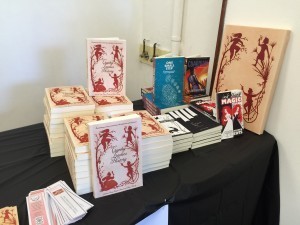
Launch table
Tansy and I arrived nice and early (with Miss 9 as offsider) to set up at The Front Gallery and Cafe – a big thanks to the venue for a great space and a great price, and friendly and helpful service. Thanks also to my work colleague Alexis who was a huge help throughout the setup and launch, completely unexpectedly but most appreciated. Our special guest Karen Middleton joined us – next time I hope I can actually have a proper conversation with her, but I think others did get to chat more – and the attendees began to trickle in. The room filled up quickly and the poor airconditioner couldn’t quite keep up with the pressure, but the launch proceeded regardless of the warmth. Karen Middleton spoke passionately and thoughtfully about the book and the concept, to the point where I was nearly in tears – it’s so great when people really get what you were aiming to do, and we couldn’t be more grateful for Karen for her time and kindness in officially sending Cranky Ladies of History out into the world.
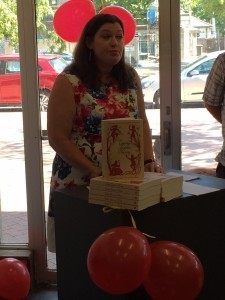
Karen Middleton talking Cranky Ladies
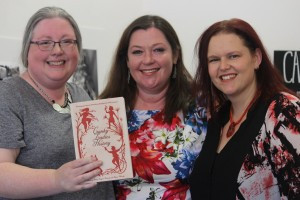
Tansy, Karen and Tehani celebrating the book
Tansy followed Karen, talking more about the genesis of the book, and then the three authors who could be with us, Kaaron Warren, Barbara Robson and Thoraiya Dyer each took a few minutes to tell the guests a little about the genesis of each of their stories. They all did a marvellous job, and it was really fascinating because each of their ladies is so different, and the reasons they each chose their lady were completely different too!
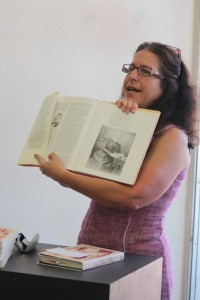
Kaaron Warren showcases the story that started her Cranky Ladies journey
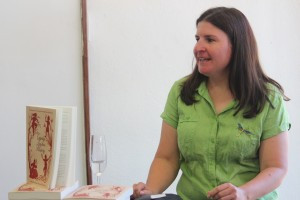
Barbara Robson describes her Theodora experience
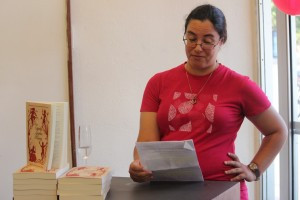
Thoraiya Dyer channels true crankiness describing Ranavalona!
Congratulations to the winners of the lucky door prizes, and a huge thank you to everyone who came to support the launch – I was delighted to see people from the local writing community, from my “day job” and other friends, alongside a huge array of people I had never met before! Thank you especially to those people who travelled from interstate to be with us (and yes, it’s not all that FAR to New South Wales, but it’s still interstate!), and to Tansy for taking a long weekend away from her family to be with us. And the most enormous thanks to Cat Sparks for her wonderful photos (all the good ones in this post are hers, I’m pretty sure!) – you can see a bunch more of them here.
Tansy and I both extend our appreciation once more to our amazing authors, our artist Kathleen Jennings, the Pozible campaign backers (and the cheerleaders for the campaign way back in March last year), Arts Tasmania, and Amanda Rainey, Elizabeth Disney and Katharine Stubbs: without all these people, the book would not be as fantastic as we know it is!
Cranky Ladies of History is now available for sale from all retailers in both print and ebook form. Please ask your local bookshop to order it for you if they don’t have it, buy directly from our website for print, or see our list of suppliers for ebook here.
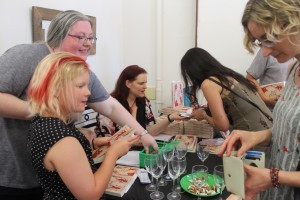
Sales table

Some of the launch crowd
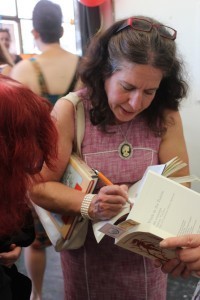
Kaaron signing (and juggling) books
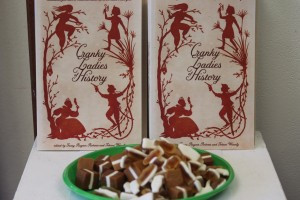
Pretties!
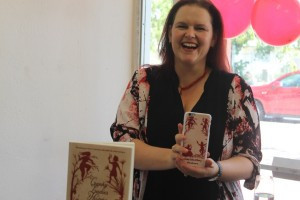
Happy publisher, showing off swag

Tansy doing her “schtick” (that’s what it said in my running sheet!)
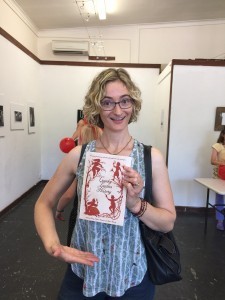
Jo Anderton models the latest in FableCroft books
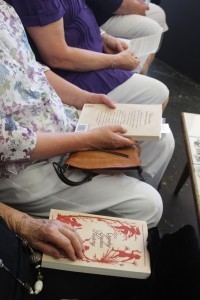
Lap books…
On International Women’s Day and “Making It Happen”
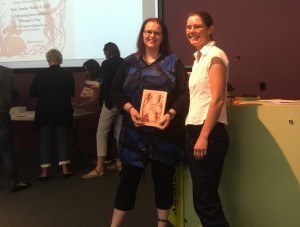
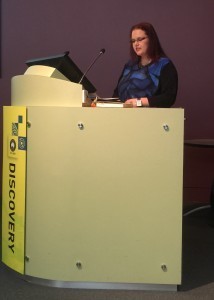 On Friday 6 March, 2015, I was privileged to speak at the CSIRO Staff Association’s International Women’s Day luncheon. When I was invited to be the guest, I have to admit I was a little intimidated – all the speakers in previous years had been women who seemed to me to be much more qualified and suitable to be part of such an event! But being me (and this may be more clear when you read what I spoke about), I jumped at the chance and spoke on Cranky Ladies and the International Women’s Day theme of “Making It Happen”. And this is, basically, what I said (with thanks to Tansy Rayner Roberts because I stole a bit of her introduction from Cranky Ladies of History – with permission):
On Friday 6 March, 2015, I was privileged to speak at the CSIRO Staff Association’s International Women’s Day luncheon. When I was invited to be the guest, I have to admit I was a little intimidated – all the speakers in previous years had been women who seemed to me to be much more qualified and suitable to be part of such an event! But being me (and this may be more clear when you read what I spoke about), I jumped at the chance and spoke on Cranky Ladies and the International Women’s Day theme of “Making It Happen”. And this is, basically, what I said (with thanks to Tansy Rayner Roberts because I stole a bit of her introduction from Cranky Ladies of History – with permission):
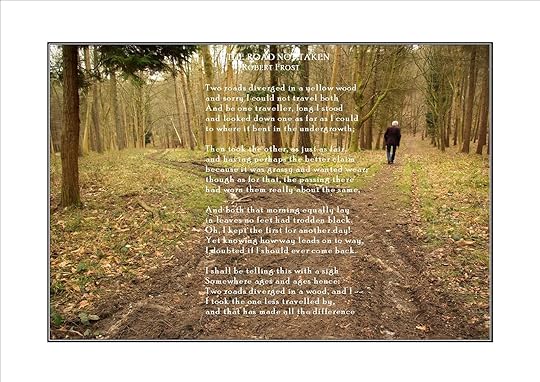
My journey has been one of branches in the path. Ever since I was a teenager, I have loved the Robert Frost poem “The Road Not Taken”, because even then, it seemed to me that that my life was about taking that less-travelled path, and I learned early on that coming back to the fork in the road is not an option. We moved around a lot when I was young – across the continent from Western Australia to Queensland and twice back again before I was 10 years old. In the olden days, before Facebook and Twitter, the letters exchanged with old friends petered out pretty quickly, and I became a dab hand at fitting in to new situations – it’s a skill that has served me well as an adult as much as it ever did as a child. People who know me will be aware that I’m rarely shy about speaking up, and I think I can thank my parents’ itchy feet for that.
But what has that got to do with “making it happen”? Well, I don’t think I would be here, making it all happen, without the journey I’ve travelled.
I wanted to show you this for some context of what I’m going to say next, but I need to note that the space I had to make it was limited, so it only shows the major moves and events – I went to nine different schools, and three universities, moved house more times than I can count as a child and a student, and we worked out that since we met, my husband and I have moved 12 times (not ALWAYS interstate…), which averages out at once per year… No wonder I’m tired!
I’m here today because of Cranky Ladies of History. This is the latest book from my boutique publishing house FableCroft Publishing, which I started in 2010. I co-edited the book with Tansy Rayner Roberts, and we did a crowdfunding campaign to finance it in March last year. It has been 18 months in the making, but it is the culmination of an even longer journey, which I’d like to share with you.
In 2001, not long after I started my first teaching job in the NSW town of Glen Innes, I came across an Internet mailing list called the Eidolist. Until that time, despite being a lifelong avid reader, I’d really had no idea that fans, writers and other creators of speculative fiction had a thriving community in Australia, with online communications and even regular conventions across the country. I grew up in small-town rural areas, where a bookshop was a rare thing and a library a blessing, but we never, to my knowledge, even had authors visit us, and even in my first university degree when I was actually on campus in Rockhampton, this sort of thing had never crossed my radar. I like to think it was because I was too busy studying and working (and to be fair, I was a full time student but often worked two jobs, up to 50 hours a week). However, I think it’s more likely I was just young, hanging with my uni mates and didn’t seek anything else out.
The Eidolist opened my eyes to this new world, but it wasn’t until the long-running magazine Aurealis came up for sale that I truly became hooked. Some people on the Eidolist started talking about forming a group to work together on Aurealis. This went back and forth for a few days, until someone suggested that instead of devoting time and money to an established project, we should start something new and different. This idea was taken up with great enthusiasm, and I was one of the mad folk who stepped up to become a founding member of the Andromeda Spaceways Co-operative, a non-profit organisation with members throughout Australia – the idea of us was so new, that the government body responsible for registering non-profits had to create new paperwork just for us! Our goal was to produce a bi-monthly publication, Andromeda Spaceways Inflight Magazine, using a blind slush process, a rotating editorship, and with a charter to support Australian creators. We paid for stories, poems and artwork, encouraged advertising by publishers and creators, and had a lot of fun along the way. By the time the first issue launched, at my first convention ever, I was pregnant with my first child, just finishing my first semester of my Masters degree and immersed in this new world. All these people who had the same interests and passions as my own? I was completely engulfed, and have remained so ever since.
While I completed three university degrees on my path to becoming a teacher librarian, I have no formal training in publishing. Instead, Andromeda Spaceways was my apprenticeship – without ASIM, I certainly wouldn’t being able to do what I’m doing now. I wouldn’t have come to know the fans, authors, artists, publishers, editors and reviewers in the Australian and International scene who I love to work with, many of whom I count as friends as well. At ASIM, I learned to edit, market, understand (very basic) contracts, commission artists, make tough decisions on stories, use layout software, and deal with artistic temperaments. I think ASIM has done some great things, for not only the Australian scene, but for many international writers and illustrators as well. I look at bookstore shelves (both physical and virtual) today and see a great many names who were published by ASIM over the years – some of these were already established authors when ASIM first saw them, but a goodly number got some very early publications in the pages of the little magazine that could, and I’m so proud and privileged to have been a part of that.
Part of what made ASIM great was the collective itself. The founding members worked so hard, ofttimes outside their comfort zones, learning new skills and creating opportunities where none existed before. It’s amazing what can happen when people work together towards a common goal. From her humble beginnings, ASIM continues to consistently publish quality fiction and being recognised for this. I left the Collective in 2008, but I took what I learned there and continued to grow (they did too – the magazine is still being published, although not on quite the insane schedule of six issues per year that we started out with!).
I left ASIM to devote more time to my family, to my day job, and to another startup small press begun by a friend of mine, Twelfth Planet Press, based in Perth. With TPP, I worked on the young adult speculative fiction magazine Shiny, and co-edited the shared world anthology New Ceres Nights, among other projects. Then, in 2010, I realised that I had projects I wanted to do myself, and so I started FableCroft Publishing.
2010 was a big year in the Australian speculative fiction community, as in August, Melbourne hosted the fourth Australian Worldcon convention. By the time we got to Aussiecon, FableCroft had two books (and a small baby, my third) to show off, and since then we have continued to grow. Our current backlist includes six original anthologies, three reprint anthologies, one single author collection, three original novels, several ebook-only reprint novels and collections, a boutique giftbook, and some stand-alone short stories, with Cranky Ladies officially launched this Sunday, another original anthology coming out in April, and several other projects on the boil.
It’s not the sort of thing I could do on my own, though in the early days I tried. Now, I am fortunate to have friends and other creators who undertake slushreading, editing, proofing, design and marketing with me, which means my books are so much better than they could possibly be if I had to rely on my own (sometimes dubious) talents! Work I have published has been shortlisted for or won awards within Australia and overseas, and one of my greatest delights is when an author I have published garners recognition for their work, whether I published it or not! After all, when I created FableCroft, it was with a charter to promote both emerging and established authors and artists in the speculative fiction field, as well as the broad genre as a whole. I like to think I do my bit, not only through FableCroft, but also with non-profit projects such as the Australian Spec Fic Snapshot, the Australian Specfic in Focus reviews website (which closed a couple of years ago) and the Aurealis Awards, which I have been involved with since 2007.
At this point, the income from running a small press like FableCroft is not sufficient to support one person (let alone a family) – for me, if each project pays for itself, and generates the seed money for the next book, that’s a win, but that’s not always the case. Even if it were, you can’t live on for-the-love, right? Luckily, I happen to love my day job – I’m a full-time Head of Information Services at an independent boys’ school, working 8am to 5pm most days. It is another facet of who I am, and I’m very lucky that I get to do something I love at work, which helps pay for my other passion.
What’s interesting is that having a day job doesn’t necessarily change my publishing output. I basically had a year off when my youngest was born (I did some online university tutoring and marking, but nothing like full-time) but I think I have achieved just as much in the past year with full-time work and an interstate move as I did in that year off. For me, it’s kind of like that story of the jar full of rocks/pebbles/sand – if you put the sand in first, the rocks won’t fit, but when you have the rocks in already, the sand fills the gaps. I think publishing is my sand – it’s what I do to fill in the gaps, and while I bemoan the fact I don’t have enough time to do everything I want to do to create and market books, I don’t necessarily know if I would achieve much more even with that time. That said, looking back it’s possible a lot of projects got STARTED during that year off which then have taken 12 to 18 months to come to fruition, so maybe that’s the kicker – when you have the time, the creativity has more opportunity to flow freely, even if it’s not an immediate payoff.
One of the interesting discussions that often comes up about women who work outside the home while raising kids is the idea that you can have it all – a great career, a fantastic home life, hobbies, relaxation, the lot. For me, I have to say that yes, absolutely, you CAN have it all…but I say that with some qualifications. First of all, you have to be realistic about what “it all” looks like. Does it involve you having an immaculate house, perfectly groomed children (and self), and a gym membership you actually use? Maybe, but for me, there are some things I have to accept I just can’t have when I’m “having it all”. And yes, an immaculate house, perfectly groomed children, and a gym membership I actually use tend to be the first areas I yield in!
Secondly, for my mind, you have to have support. That might be in your life partner, your extended family, your colleagues, your friends, or in all those people, but without it, it’s hard going. Every time we move, we struggle, because without local networks, friends, established work schedules and so on, things can be lonely and pretty tough. Interestingly, this is an area where my publishing life has had a positive impact on my family life – everywhere we have moved to in the past 8 years has been within shouting distance of people I’ve come to know through publishing, many of whom I count among my closest friends.
In terms of what “making it happen” with a full-time day job and a publishing “hobby” looks like for me, I have four children aged 2 to 12, and a husband who works away a lot of the time. Last year when I took on my new job, which involves more responsibilities and a bigger time commitment than other jobs I’ve had, we made the decision that trying to manage that, with a growing family, just wasn’t practical. Instead, we engaged a live-in au pair, and it was one of the smartest moves we’ve ever made. I know that’s not feasible, or desirable for everyone – it’s a financial imposition in many ways: we have to have a larger house, we have bigger food bills, the travel costs are not insignificant, and of course we pay our au pair a wage, and there is a certain loss of family privacy alongside that. But having a great au pair means I can give my career the time it needs to grow, while knowing my children are being well cared for, taken to their after-school activities, fed and entertained, when my husband and I can’t be there. Are we working to pay for childcare? Maybe. Are we making it happen. You bet.
I’m very fortunate, in many ways, but especially because while my husband doesn’t always get WHY I publish, he still fully supports me. More often than not, this support is by way of time rather than money. I mean, every dollar I have put into the press could have been going towards the family holiday or mortgage I suppose, but it has been much more about the ability to be able to go to things like conventions, to sell books, network with authors and so on. Without his support, I wouldn’t be able to do that as easily.
There have definitely been times I get a bit stressed about whether or not I can actually maintain the financial commitment or time necessary to make the projects happen, but so far, we’ve always managed it. That said, I did make a choice late last year to pull back on some of the projects I’d been considering, due to both financial and time pressure. It was a really tough decision, and they were hard emails to write, because I think if you aren’t trying new things and looking at new opportunities, it’s really hard to gain traction. But if I can’t make the best effort at the projects I’m doing, they aren’t going to be worth it anyway. Publishing has such a long lead time and an even longer follow through, if you don’t want projects to sink without a trace. I think that’s what I’m trying to find the balance with at the moment. The editing and book production isn’t really the problem. I think I could continue that load or even increase it, if that’s ALL I needed to do. But it’s not. It’s the rest of the publishing process that takes the longest time. And that’s where my guilt comes from – taking time away from my family to make these books. I can only hope that in the future, my kids see me following a passion and working hard to achieve my goals, and they take some of that away for their own lives, not just all the time Mummy spends at the computer rather than playing with them…
Although money is a part of it, I think the time devoted to “making it happen” is definitely the biggest sacrifice. But you know what? If I wasn’t making books, I’d almost certainly be doing something else with that time, and it’s not a guarantee that something would be hanging out with the kids, I’m afraid! It might be something less deadline-specific, I suppose. Maybe it would be exercise…
What would be the ideal? I’m not sure there is one. I genuinely love my day job, and at this stage, I wouldn’t want to give that up. I am well paid in my role, more so than I would be in most roles even in the mainstream publishing industry, so I can’t see us being in a position for me NOT to have a day job any time soon. However, one day, maybe, I think I would love to be able to either focus entirely on FableCroft or, should an opportunity arise, perhaps take on a position in a large publishing house. You never really know what the future will bring – for now, everything I do is another string in my bow to potential future prospects. And we’ll see where life takes us!
And that brings us back to Cranky Ladies of History, which was one of those projects that pretty much sprang fully formed into being. It began with a face, glaring out from an oil painting. Australian social justice and media blogger Liz Barr posted an image of Tsaritsa Sophia Alekseyevna of Russia on her Tumblr account and then, receiving a hugely positive response to Sophia’s fierce expression, wrote a short essay about the woman in question, calling her a “would-be usurper, all-around cranky lady”. There’s something about that phrase: cranky lady. There was a time when it would have been seen entirely as a put-down, a dismissal of female strength and power. Yet the idea of celebrating women for their crankiness—rather than their beauty, their docility, their compliance—feels empowering and deliciously rebellious. It was a phrase that struck me immediately, and when I tweeted about how much I’d love to read stories about cranky ladies of history by some of my favourite authors, the response was instant and immediately positive. Within hours, the idea had coalesced into a concept, and then into a plan, which continued to grow as the interest did. I dragged in my friend, writer and classics scholar Tansy Rayner Roberts, as a co-editor, because I knew I would need someone with more expertise than my own for such a project, and having her on board added so much more than just her knowledge – her understanding of crowdfunding, her network of followers and her writing and editing prowess made things happen that I just couldn’t have achieved on my own.
From the start, when we talked about ‘Cranky Ladies of History’ as an anthology concept, people got excited. These days, when we give people advice about setting up successful crowdfunding campaigns, one of the first things we tell them is to choose the idea that sells itself—where people get excited from the first sentence, from the title of the project, before you’ve even explained all the nuts and bolts and rewards and payment options, you know you’re on a winner.
Cranky Ladies was one of those ideas. We found ourselves in a whirl of positive interest, not only from writers who wanted to pitch stories to us, but from mainstream media and many people who didn’t have the time or the inclination to write for the book, yet still wanted to support it, to promote it, and to help out with the campaign.
Crowdfunding is one of the new norms in publishing, and has helped many small presses remain viable in a time when the entire book industry is in flux. One of the best things about crowdfunding is the ability to test ‘proof of concept’ and find out if your publishing idea has legs before everyone invests all their time and money into it.
So many people we talked to wanted this book to exist, even if they weren’t personally involved, and that turned out to be crowdfunding gold. We pulled in many of our most enthusiastic activists to help with the campaign, to blog about their favourite cranky ladies, and to spread the word. We had chosen March (Women’s History Month) for the campaign almost on a whim, thinking it would be cute, but the further we got into the month the more we realised that people were hungry for these stories, not even just the fiction that we promised, but the anecdotes and essays about lost and misquoted and reclaimed women from history who were fierce, uncompromising and yes, cranky.
The positive response we received to the Cranky Ladies crowdfunding campaign was invigorating and inspiring—especially when International Women’s Day brought national media attention to a book that didn’t even exist yet. When you’re making art that you think is challenging, rebellious and potentially controversial, there is nothing better than the feeling of having a crowd at your back, putting their money where their mouth is, cheering loudly, and keeping you company every step of the way.
Once the month of crowdfunding was over, the real work began. The authors whose pitches we had accepted had stories to write—and not every story was going to make it into the final volume. We weren’t just looking for great stories, but also for a diverse mix of authors and historical figures, so that the book would cover a wide range of time periods, cultures and topics. Quite honestly, we could have filled the book just with female warriors of history, or pirates, or queens, but we wanted to show as many different ways as we could that women had rebelled against their society’s conventions—or, in some cases, worked covertly within those conventions.
It was hard to accept that we couldn’t have everything. Each story we rejected felt like we were losing a piece of the big picture we had wanted to create. We also had to accept that some of the stories we had hoped for simply didn’t come to us at all. We would have loved to include more pilots, sportswomen, scientists, and an even broader range of cultural diversity. We are particularly disappointed there are no Indigenous Australian authors in the anthology, and while we did receive a story that we deeply loved featuring an Aboriginal protagonist, we ended up having to let it go because of issues to do with cultural permissions that could not be addressed in time for us to go to print. This was possibly the most difficult choice I had to make with the book, and I remain very sad about it, although I stand by our decision to respect the cultural dictums in the matter.
Cranky Ladies of History had its official launch this weekend. Thanks to amazing authors, the efforts of my incredible co-editor, the work of a fabulous artist and a talented designer and eagle-eyed proofreaders, this book is my best production so far. I couldn’t have done it without every single one of them, nor without the people who had enough faith in our ability to make it happen that they put their hands in their pockets an entire year ago, when the book was still just a concept on a webpage. And I couldn’t have done it without the support of my family: my parents, who inadvertently set me on this path nearly 40 years ago, and who have always been there when I’ve needed them (and my dad reads all my books, even though he doesn’t like the genre!); my kids, who have shown excited faces when Mummy has been squeeing about an author’s story that blew me away, or about exactly HOW PRETTY the books have turned out, even though they don’t really understand why I’m so happy about it all; and my husband, who is as proud of me as I am of this book.
It’s always interesting to look back at the choices one makes to trace the path back to where things began. The movie Sliding Doors does this literally, showing that we really can’t ever know what will come of the decisions we make in life – sometimes those that seem the best can have unhappy endings, and on other occasions, something awful can lead to something amazing. Often, the outcome is not what we anticipate, and often the reason is not the alternatives presented to us, but the attitude with which we attack them. I finished Year 12 as an only-just 17 year old, and I remember being quite distressed that I didn’t get my first preference for university courses. On the third round of offers, my first preference was given, but by then, I had accepted a position as a governess on a remote cattle station in the Northern Territory. I deferred my course and took the gap year (not that we called it that back then!), and it was fantastic. Then, when it came time to reconsider my options, I decided that actually I really DIDN’T want to do that original course, so I reapplied for different universities. This time, when the offers came and again I didn’t get my first preference (this time, it was the right course but in the wrong city), I remember sitting down and crying. Then suddenly I realised that actually, not getting my first preference the last time had turned out to be a good thing, and I distinctly remember thinking “Everything happens for a reason.” In that moment, my whole perspective changed. I went to the new, unknown city. I made friends and embarked on a path I had never imagined. In one way or another, every choice I made then has led me to where I am now. I could never claim that it’s been a smooth road – I’ve hit boggy spots, and wheel ruts and even veered right off onto the tiny gravelled side roads sometimes! But the road has led me here, and what I see in my rear view mirror gives me joy.
March 3, 2015
CRANKY LADIES OF HISTORY: A few notes on Nora (of Kelmendi)
 Welcome to Women’s History Month 2015, which has the theme “Weaving the stories of women’s lives”, which fits perfectly with our Cranky Ladies of History anthology project! After 18 months of work, including our successful crowd-funding campaign in March last year, we are proudly releasing the anthology on March 8. To celebrate, our wonderful authors have supplied blog posts related to their Cranky Lady, and we are delighted to share them here during the month of March.
Welcome to Women’s History Month 2015, which has the theme “Weaving the stories of women’s lives”, which fits perfectly with our Cranky Ladies of History anthology project! After 18 months of work, including our successful crowd-funding campaign in March last year, we are proudly releasing the anthology on March 8. To celebrate, our wonderful authors have supplied blog posts related to their Cranky Lady, and we are delighted to share them here during the month of March.
To get your own copy of Cranky Ladies of History, you can buy from our website, order your favourite real world bookshop, or purchase at all the major online booksellers (in print and ebook).
A few notes on Nora by Havva Murat (“The Pasha, the Girl and the Dagger”)
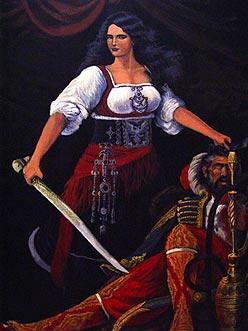
Nora in traditional Albanian garb and with the Pasha’s head firmly in her grip
Nora of Kelmendi, literally from Kelmend: a remote, mountainous region of Northern Albanian that flows into both the neighbouring countries of Montenegro and Kosovo, was born around 1630 AD. The cultural melting pot that is the Balkans, had by this time been held for around 200 years (from circa 1431) by the Ottoman Sultans and their local (in this instance, Bosnian) Pashas, taken after a series of bloody medieval wars that saw the lowlands fall into the hands of the Turks and the highlands foster and give birth to many uprisings. Nora, born into a Roman Catholic Family, became renowned as the greatest female warrior in the history of the country for killing the aforementioned Pasha in a duel (although her feats are more the stuff of legend than historical fact, but we won’t let that get in the way of a good story). It is interesting to note here that there are still many Roman Catholic families living in this region of Albanian today despite the fact that the majority of Albanians converted to Islam while under Ottoman rule – but not the Kelmend! This group were determined to hold onto their own faith and customs in the face of the Ottoman threat and thus their reputation as the most stubborn tribe in the nation grew.
POTENTIAL SPOILERS FOR “THE PASHA, THE GIRL AND THE DAGGER” AFTER THE CUT – check out the story in Cranky Ladies of History before you read!
There are two versions of how Nora managed to down the Pasha after he threatened to destroy her homeland if she didn’t marry him, and while scintillating, I decided instead to focus my story on the odds she overcame to rise to a position of respect in a fiercely patriarchal culture. And Albania is fiercely patriarchal still…but getting back to the legend, Nora’s gender rendered her useless to a macho, warrior father whose first priority was to raise an army to repel the advancing Ottomans. So it was that he abandoned her at an orphanage shortly after her birth and her aunty secretly adopted her (Besjana rocked in the legend as much as in my story). Skip forward some years and Nora’s father decides to train his sister’s ‘adopted son’ as a knight who then, of course (and this cross-dressing part wasn’t explained in the legend), grows into the most beautiful woman around. At this point the Pasha just thinks Nora is a hottie and little does he realise that he is going to meet his end at her beautiful hand. And so the Pasha, now living in Shkodra, falls instantly in lust with Nora at first sight (love might be a bit of a stretch for a man with a vast harem) and quickly sends an emissary to ask for her hand in marriage, but her fiercely proud father refuses to give her in marriage to a non-Albanian. So we can see that the turbulent history of the Balkans goes back a long way with so many squabbles over land, wealth and nationality.

Medieval Albanians in traditional costume having a party and sword dance
I chose to end my story with the first meeting between Nora and the Pasha, (as well as add a tournament that isn’t in the original legend), but for those who want to know what happened after the Pasha was so eagerly snubbed by the Kelmendi, here are the two versions:
Nora pretends to want to marry the Pasha, gets dressed in traditional clothes, goes to his tent, woos him, stabs him with the magic dagger, chokes him…but he survives. He follows Nora home, they duel and then he really dies.
There is no clandestine trip to the Pasha’s tent. Instead Nora leads a troop of 300 Albanian women to tackle the Ottomans as they come in to rape and pillage whilst the Albanian men are on the battlefield. Nora meets the Pasha and kills him in a duel, fair and square.
Either way Nora kicks butt and teaches the Pasha that you can’t force a cranky Albanian woman to join your harem, whilst also teaching her father that having sons is overrated when you have a daughter that can wield a dagger as well as she woos a man. Dagger wielding and Pasha killing definitely land Nora a firm place in the Cranky Ladies of History annals. Now to think of what I can do to land mine! Hope you enjoy all the fantastic stories in the anthology and get as inspired by this project as I have.

Map of Albania and surrounding region showing Shkoder (top left) next to Lake Scutari

Ruins of the Rozafa Caste, home of the Pasha, (on hill top) at Shkodra, Northern Albanian

